Trail running shoes vs road running shoes: what's the difference?
We compare the mud gripping, peak slaying trail running shoe to the marathon conquering, asphalt pounding road running shoe
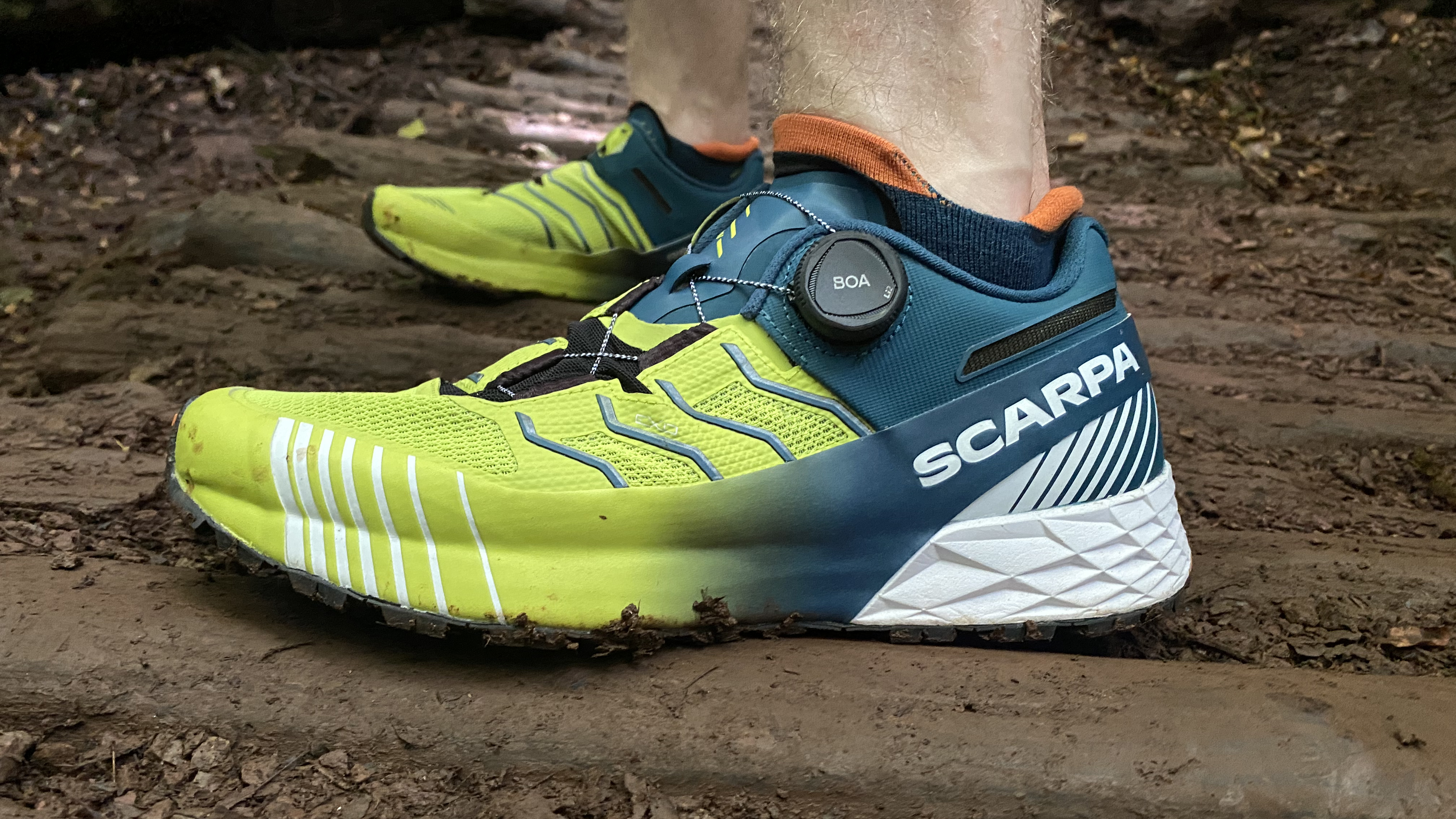
Every running shoe is different. Some are designed to grip wet rock like limpets; others are designed to provide propulsion on tarmac for mile after mile; some are as comfortable in the mud as little piggies; while others are minimal, lightweight and intended for race day. However, the two main sub-categories of the running shoe are trail shoes and road shoes.
Our running expert is here to break down the differences when it comes to trail running shoes vs road running shoes, from the upper to the sole.
Trail running shoes typically feature:
Protective uppers: a trail running shoe's upper is crafted from more durable and protective materials than a road shoe, where breathability is the main desirable. A trail shoe has to bat away rock abrasion, trail debris and brushes with prickly undergrowth and is designed as such.
Tougher midsoles: whereas a road running shoe's midsole is all about cushioning and propulsion, a trail shoe's is much stiffer, more protective and typically not as cushioned. This provides stability on uneven terrain, while the lack of cushioning provides more "trail feel", allowing the wearer to be more responsive to what's beneath their feet.
Aggressive outsoles: trail shoes have to grip soft surfaces, hard rock and everything in between. As a result, their outsoles are made from more durable rubber with lengthy lugs for biting into the ground. The outsoles of a road shoe are much smoother.
Less drop: trail shoes generally have a lower heel-to-toe drop to provide better ankle stability.
All the latest inspiration, tips and guides to help you plan your next Advnture!
Comparison table
| Row 0 - Cell 0 | Trail running shoes | Road running shoes |
| Outsole | Material, design and lugs to provide traction on trails | Smoother outsole for speed on tarmac |
| Cushioning | Generally less cushioning for greater ground-feel | More cushioning to reduce pounding impact |
| Heel-to-toe drop | Lower drop so the foot is closer to the ground for improved proprioception | Larger difference to protect the Achilles tendon and legs from tarmac impact |
| Medial post | Less likely to have a medial post | Medial insert to help with stability on flat ground |
| Upper | More details for improved durability, plus water resistant or waterproof | Lightweight and less requirement to have extra durability features |
| Lacing | More technical lacing for support on rough trails | More straightforward lacing system |
| Price | Can be more expensive due to greater need for technical design and features | Usually cheaper because the shoe will be more straightforward |
Meet the experts

Fiona loves running in all its forms. Based in the Scottish Central Belt, just a stone's throw from the Southern Highlands, she has a wealth of excellent road and trail running right on her doorstep.

Alex is a regular trail runner and loves moving fast and light through the mountains. He started off road running in his early twenties and started making the transition to trail running after having an absolute ball on one of the English Lake District's Lakeland Trails races. Since then, he's taken on Wales' 15 highest peaks in a single circuit and competed (if you can call it that) in the legendary Ring of Steall Skyrace in the Scottish Highlands.
Today's best deals
The outsole
- The outsole is the part of the shoe that's directly in contact with the ground
- Trail running shoes' outsoles are designed to grip varied surfaces
- They often feature a lug pattern for traction on muddy terrain
- Road running shoes tend to have a smoother outsole
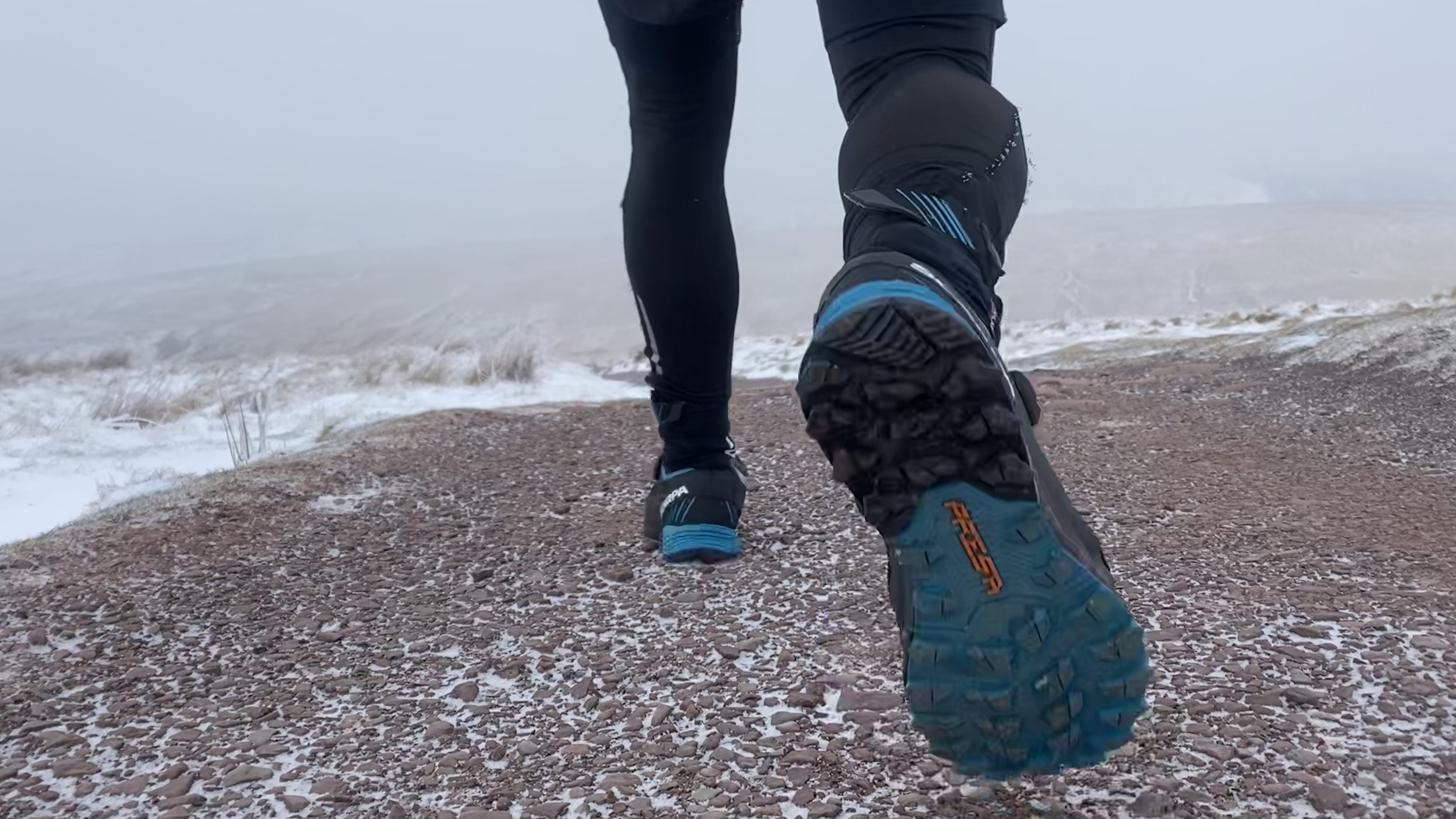
The sole of a running shoe comprises the outsole and the midsole. Each of these components will be structured and designed differently in road running and trail running shoes, making them more suitable for the type of terrain they will be used for.
The outsole is the part of your shoe that is in direct contact with the ground. A trail running shoe therefore needs to have greater traction or grip because runners will be on a range of surfaces, such as wet rock, mud, grass, stoney paths and steep slopes.
If you look at a trail running shoe outsole there will be a design, including lugs or studs, to grip the rough terrain. Trail shoes like Inov8's X-Talon 255 or Salomon's Speedcross 6 are designed with very aggressive, long lugs for traction on muddy terrain. However, not all are this aggressive and I've slipped and slided about on mud in trail shoes that weren't as tailored to the conditions.

Trail running shoes usually have a stickier compound on the sole to ensure runners have grip on rocky and uneven terrain. The depth of the lugs will vary depending on what the trail running shoes are intended for, from rough park paths to mountain tracks. Other trail running shoes feature materials, such as graphene, to offer increased durability and improved grip on a range of trails.
In contrast, a road running shoe will generally have a smoother sole. There's much less need for traction on tarmac and so the focus of the running shoe will be on a smooth and fast cadence.
Cushioning
- Road running shoes are typically more cushioned, as they're designed for hard surfaces
- Trail surfaces are softer, so cushioning isn't as important in trail shoes
- The ability to feel the terrain is important in trail running
- The more cushioning there is, the less you can feel the ground beneath
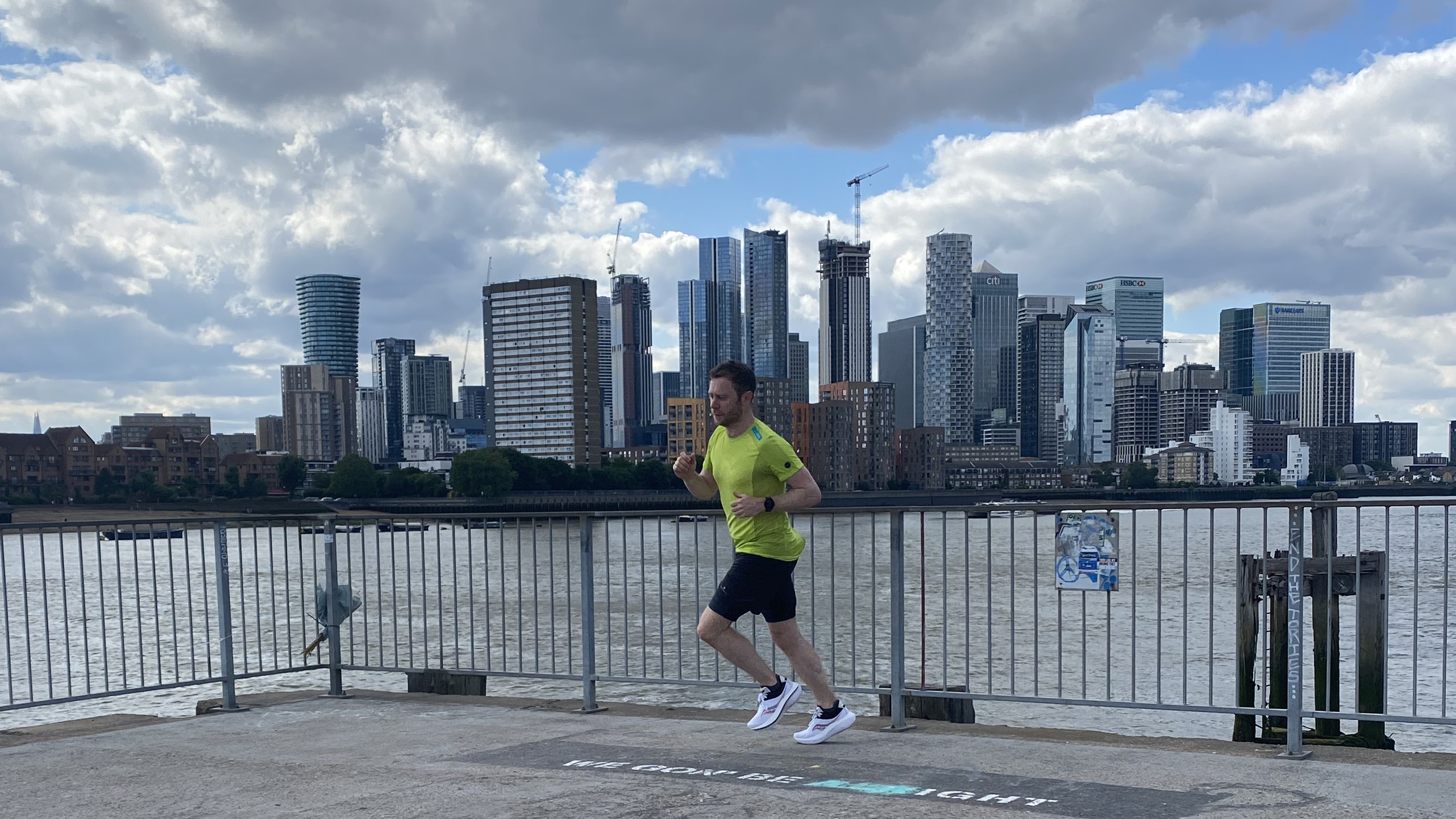
The midsole is the part of the running shoe that sits between the outsole and the insole. This is the area of the running shoe that provides the most cushioning. It is usually made from a foam material and the levels of cushioning varies in a number of ways.
In general, road running shoes are typically more cushioned than trail running shoes because they are meant for hard surfaces. Meanwhile, trails are generally softer underfoot and create lower levels of impact so the cushioning is usually lower in a trail running shoe. I've ran many sections of road in trail running shoes and it's a very different experience to running such stretches in cushioned, propulsive road shoes.
In addition, when trail running, proprioception is important. Proprioception the sense of self-movement and body position and refers to how the muscles, tendons and joints work together to provide awareness on uneven surfaces.
When you are running off-road, you need to be able to trust in your footwear and the sense of where your foot is and therefore it's often better to have less cushioning underfoot and greater "ground feel", which allows you to be more responsive. I hate running on even terrain wearing cushioned road shoes, as I feel dangerously imprecise.
Find out more by reading: how to choose trail running shoes: drop, sole, grip, weight and more explained.
However, there are some trail running shoes, especially from brands such as Hoka One One, that have higher than average levels of cushioning. There are also road running shoes that have reduced levels of cushioning, for example, a lightweight and minimalist road running shoe that is meant for races, compared to a road running shoe that will be used for ultra distance running training and races.
In addition, it will depend on the needs of the runner. Some runners like more cushioning, whether they are running on trails or tarmac, while other runners prefer more minimalist, in-contact-with-the-ground cushioning. We reckon it's often a personal choice when choosing the best trail running shoes or road running shoes.
Heel-to-toe drop
- The drop is the difference in height between the heel and the toes
- In road running shoes, this is usually higher in order to protect the achilles
- In trail shoes, it tends to be lower to provide improved ankle stability
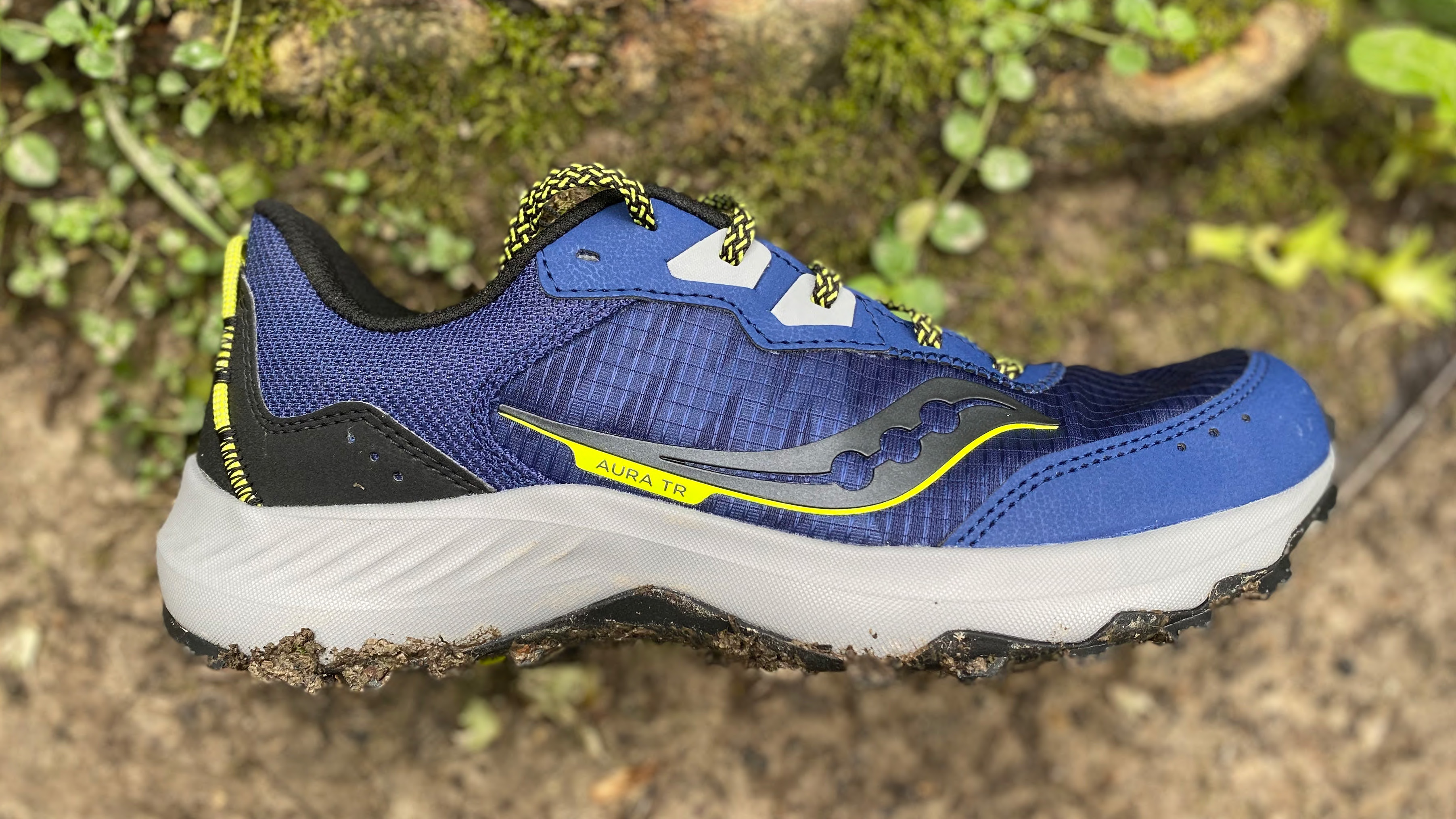
Heel-to-toe drop refers to the difference in the thickness of the the midsole, from heel to toe. With road running shoes, the drop is usually larger to protect the Achilles tendon and legs from the pounding impact of running on tarmac.
Meanwhile, with trail running shoes, the heel-to-toe drop is generally lower, which means the foot is closer to the ground. This helps to provide improved ankle stability and, as above, it enhances a runner’s proprioception.
Medial post
- The medial post is an insert of harder-density foam in the midsole
- Trail running shoes don't have these as the foot needs freedom of movement
- Stability road running shoes will contain a medial post
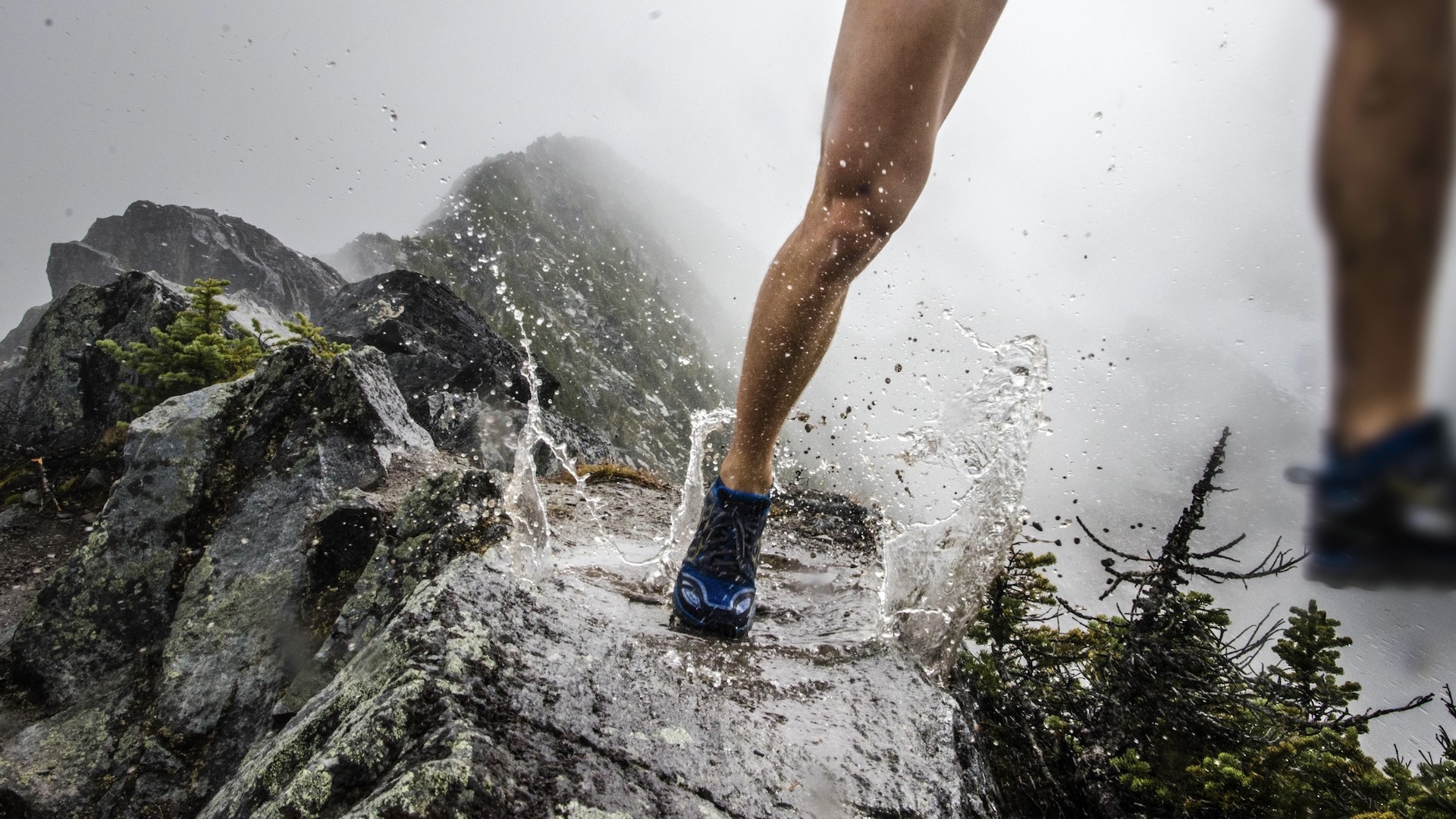
The medial post is an insert of harder-density foam that is positioned on the medial side (inside) of the midsole of the shoe. The aim of the medial post is to control excessive pronation, depending on your running gait.
Road running shoesd that are classed as “stability road shoes” will have a medial post, while most trail running shoes have no medal post so there is no restriction in the natural motion and movement of the foot.
The upper
- The upper of a trail shoe tends to be more durable and robust
- A trail running shoe often features a protective rand between the sole and upper
- Toe caps and heel protectors also offer enhanced protection against the trail
- Some trail shoes are also waterproof
- Road running shoes' uppers are made from thinner, more breathable materials
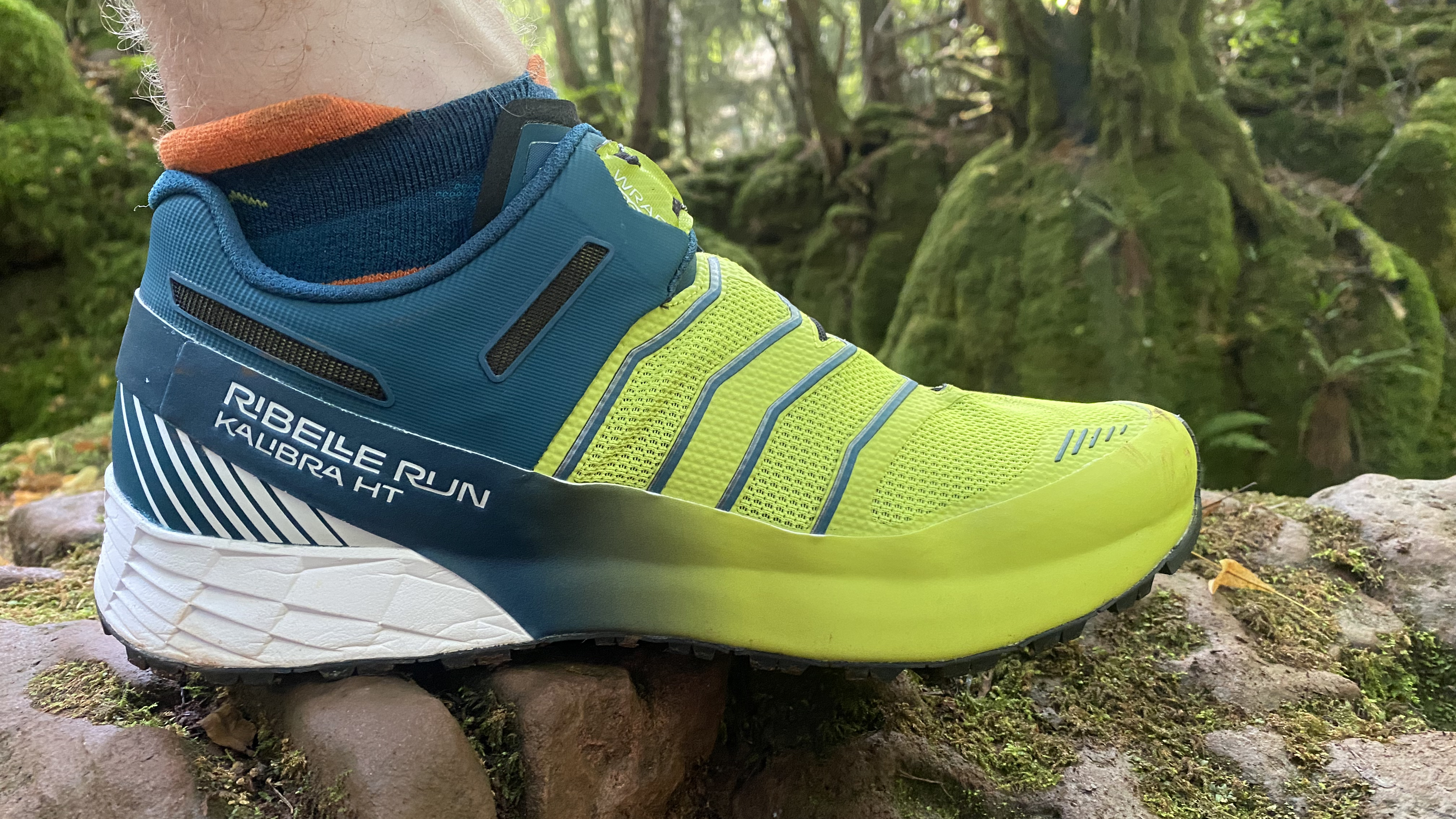
The upper in a running shoe comprises fabric, rand and heel collar, as well as tongue and lacing. If you compare trail running shoes vs running shoes, you’ll see that the upper is made of sturdier and tougher materials to protect your feet and so as to withstand trail terrain and hazards, for example stones, rocks, vegetation and tree roots.
Trail running shoes will have a more robust and protective rand. This is the area of the shoe between the upper and sole and where a material overlay circuits the shoe. The rand helps to maintain the fabric upper by adding protection against natural hazards and obstacles. I always feel that my feet feel more protected in a trail running shoe. The addition of a toe cap or heel protector also provides increased durability.
Trail shoe uppers might also have a water repellency treatment or a Gore-Tex liner to keep feet drier. However, some trail shoes are deliberately designed with a breathable mesh to stop feet from becoming too hot and also to allow water that gets into the shoe to also escape again.
With road running shoes, the upper is usually lighter and thinner, providing greater breathability and less protection.
The shape of the upper and the fit and feel will be different from brand to brand, whether it’s a trail running shoe or a road running shoe. It’s a good idea to try on shoes before buying them.
Lacing
- Trail running shoes often feature gusseted tongues to keep trail debris out
- Their lacing systems have more variety, with "stay-tied" laces the norm
- Salomon's quicklacing or similar and the BOA fit system are often seen
- Road running shoes' laces don't have to be quite a technically adept
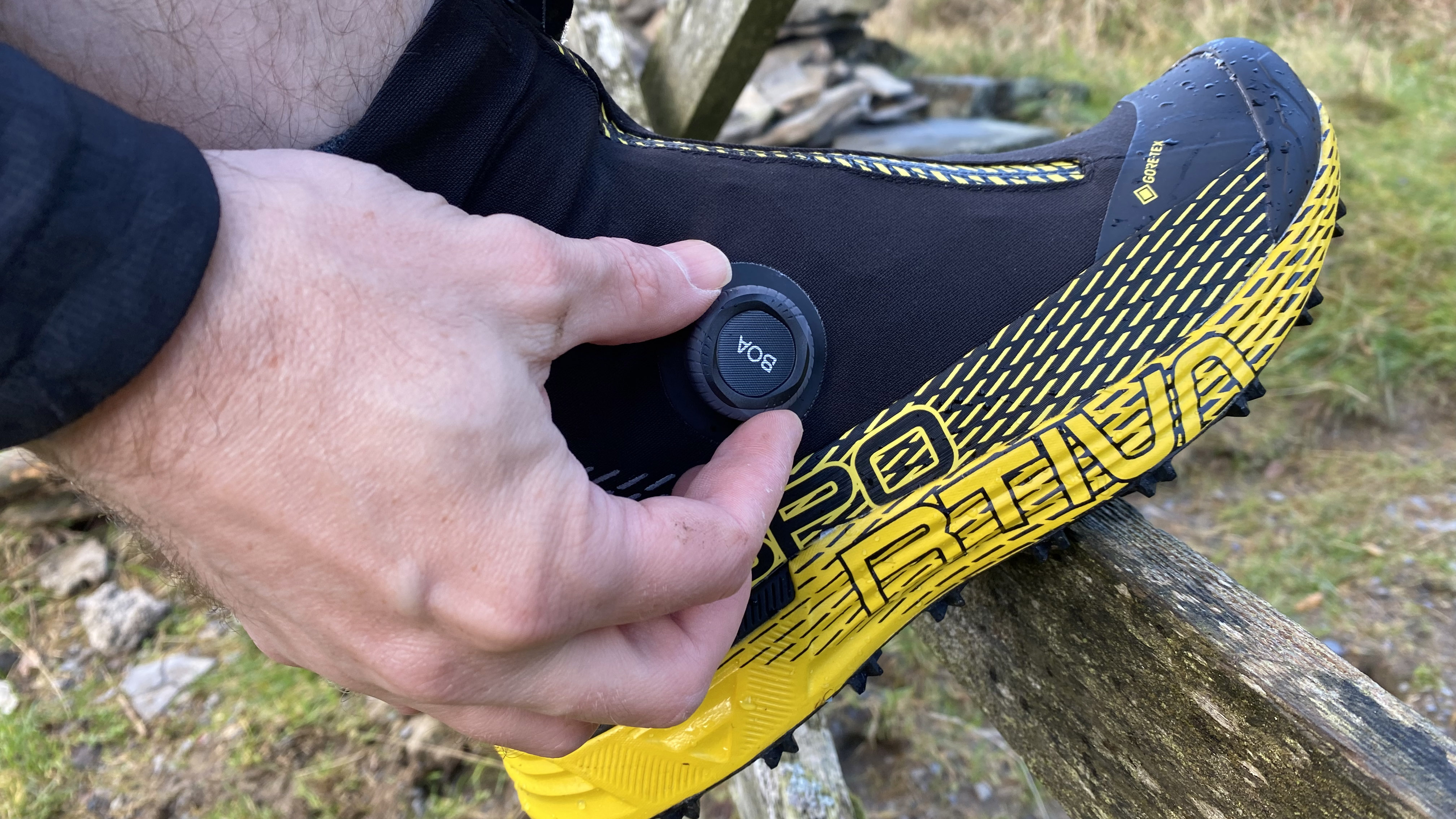
The tongue and lacing is the part of the shoe that can be adjusted to allow your foot to slip inside and also then to provide support when you run.
The tongue of a trail running shoe might be designed with a stone guard, so as to keep small bits and pieces of the stone, grit and vegetation out of the shoe.
Trail running shoes should also support a runner's feet throughout a run on rough terrain. Look for "stay-tied" laces, such as those with locks or knobbles along the length of the lace.
Some brands have developed lacing systems to keep feet supported, such as the Salomon quicklace that uses a toggle lock to allow for an even adjustment of lacing along the shoe and also to keep laces tied. Brands have also recently been making use of the BOA Fit System, seen in La Sportiva's Cyklon and Cyklon Cross GTX and Scarpa's Ribelle Run Kalibra G and Ribelle Run Kalibra HT, to name a few.
The tongue and lacing area of a road running shoe should also be comfortable and easily adjusted and laced to offer good support. However, because road running is a more even and repetitive activity, with far less foot and ankle movement compared to off-road, there is less requirement for a highly technical tongue and lacing system.
Price
- Trail running shoes are generally more expensive, though it's not always the case
- The need for increased durability and greater technical design are the main reasons for this
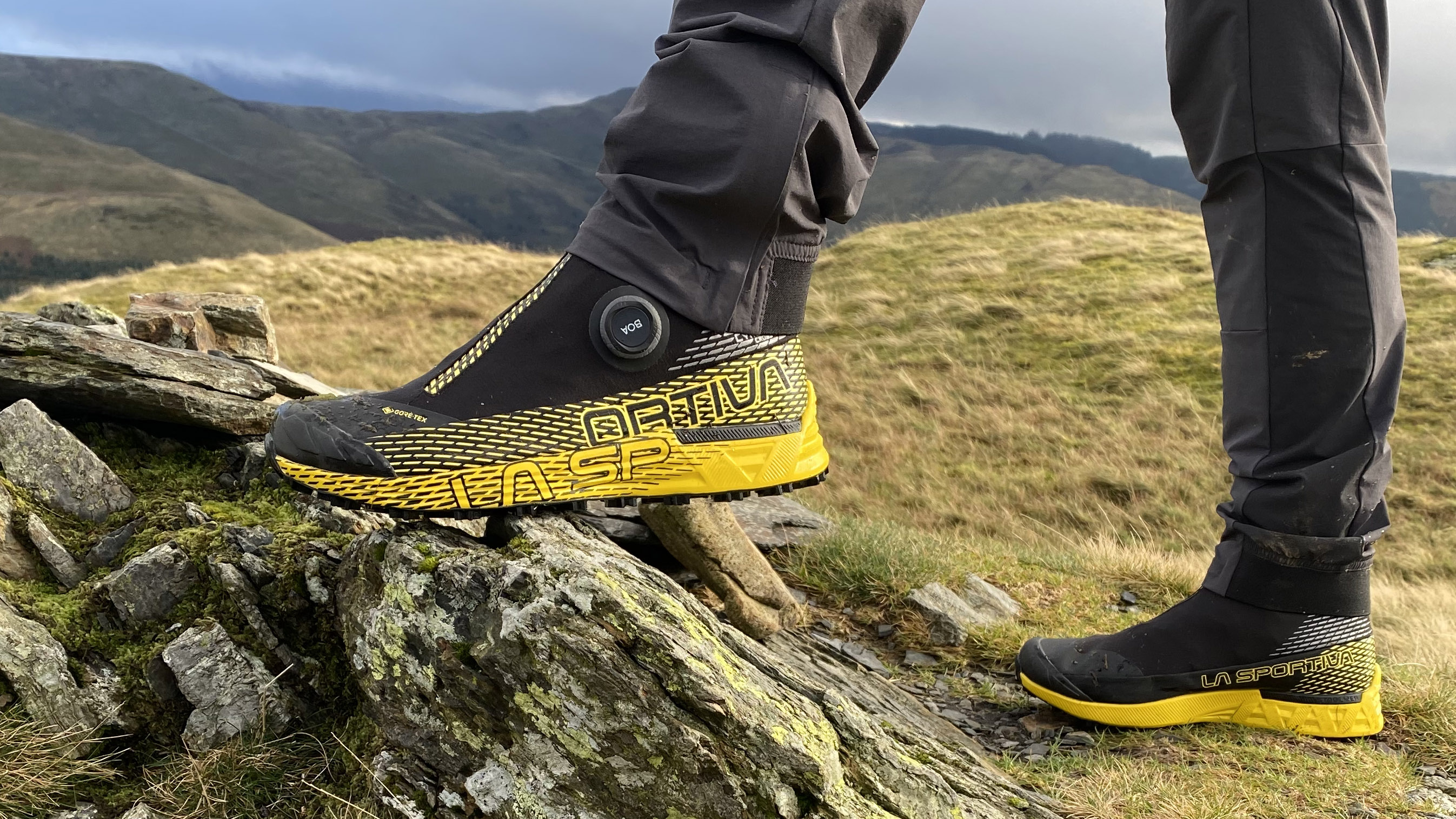
Trail running shoes often command a higher price tag because of increased need for R&D (research and development), plus a need for greater technical design and features to increase longevity of the footwear when subjected to the rough nature of trails.
Read running shoes will generally be a bit cheaper due to a more straightforward design.
However, the above is a generalisation and it will depend on the brand and how the trail and road running shoe is developed, designed and manufactured.
Frequently asked questions
When should you use trail running shoes?
Basically, if the terrain is going to be hard and even underfoot, road shoes are the best bet. Anything else, you need trail running shoes.
The thing about the word trails is that it covers a whole range of terrain types. From compacted gravel and rocky paths to grassy trods and muddy farm tracks, all of these may be considered as trails.
For all the above, aside from perhaps the compacted gravel, trail running shoes will perform better than road running shoes thanks to their increased grip, protection and ability to handle uneven terrain. Trail running shoes are also great for going off-piste across access land: think open moorland and rocky mountain scrambles.
Are trail running shoes better for Parkruns?
This really depends on the situation. After a July heatwave the surfaces encountered on a Parkrun are likely to be just as hard as tarmac and a cushioned road running shoe would almost certainly be the better choice. On the flip side, in deepest, darkest winter, the terrain may be sloppy to say the least. In this case, a mud gripping trail shoe would be much more appropriate for the task at hand.
Some brands have dreamed up hybrids designed for Parkruns and the like, such as Inov8's Parkclaw G280.
Can you run trails in road running shoes?
We wouldn't recommend running trails in road running shoes, as they won't provide the grip often needed and they probably won't give you as much "trail feel", which is what allows you to respond to the intricacies of uneven ground.
Road running shoes are designed for hard, even terrain. If your local trails are completely dry and relatively even, your road shoes may be fine. However, if you regularly hit the trails, a pair of trail running shoes will serve you much better.
Can I go hiking in a pair of trail running shoes?
We're often asked, are trail running shoes good for hiking? Our answer is always the same:
For fast and light summer hiking, trail running shoes are great. However, if you're carrying a heavy load or venturing out in colder, wetter conditions, proper hiking footwear is a must. Of course, every scenario is different but as a general rule, there's nothing wrong with hiking in trail shoes and their lightweight qualities make them a comfortable option.

Fiona Russell is a widely published adventure journalist and blogger, better known as Fiona Outdoors. She is based in Scotland and is an all-round outdoors enthusiast with favorite activities including trail running, mountain walking, mountain biking, road cycling, triathlon and skiing (both downhill and backcountry). Aside from her own adventures, Fiona's biggest aim is to inspire others to enjoy getting outside and exploring, especially through her writing. She is also rarely seen without a running skort! Find out more at Fiona Outdoors.
